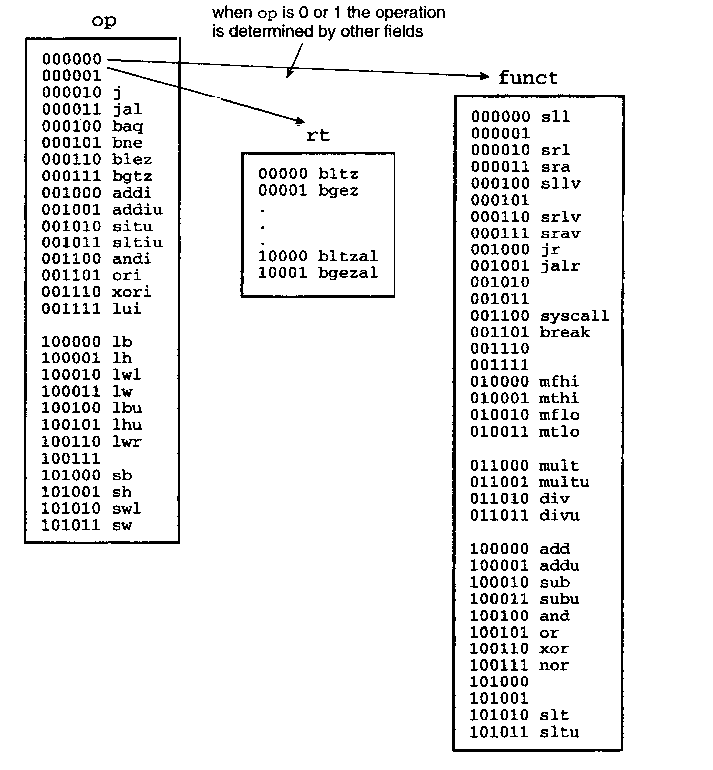CS201 Lab: MIPS Addressing Modes
There are different ways to specify the address of the operands
for any given operations such as load, add or branch.
The different ways of determining the address of the operands are
called addressing modes.
In this lab, we are going to explore different addressing modes
of MIPS processor and learn how all instructions can fit into a
single word (32 bits).
MIPS Instruction Formats
There are three types of instruction format. They are Register Type, Immediate Type, and Jump Type.
The meaning of the different parts in each format: op - 6-bit operation code rs - 5-bit source register specifier rd - 5-bit destination register specifier rt - 5-bit target (source/destination) register or branch condition immediate - 16-bit immediate branch displacement or address displacement target - 26-bit jump target address shamt - 5-bit shift amount funct - 6-bit function fieldThere are different MIPS addressing modes. We have already seen some examples in the previous labs.
Here are the four addressing modes:
- register addressing mode
- immediate addressing mode
- base addressing mode
- PC-relative addressing mode
introduce indexed addressing mode, which is implemented by the assembler as a pseudo instruction.
MIPS Register addressing
The simplest addressing mode is the register addressing. Instructions using registers execute fast because they do not havethe delay associated with memory access. But, the number of registers is limited since only 5-bits are reserved to select a register.
Register addressing is a form of direct addressing. The value in the register is an operand instead of being a memory address to an operand.
Now look at an example:
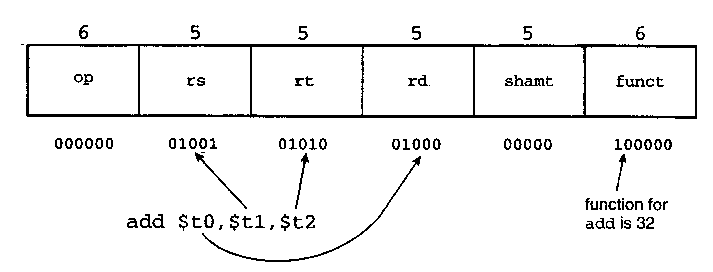
The following table shows some of the opcodes used by MIPS.
The value of rs, rd, rt should be the actual register
number, and can fit in five bits since there are 32 registers.
MIPS Immediate addressing
MIPS immediate addressing means that one operand is a constant within the instruction itself.The advantage of using it is that there is no need to have extra memory access to fetch the operand.
But keep in mind that the operand is limited to 16 bits in size.
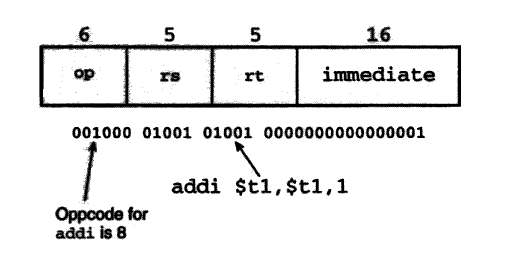
The jump instruction format can also be considered as an example
of immediate addressing, since the destination is held in the
instruction.
Here is a reference for you: The Jump Instruction

MIPS Base addressing
In C++ programming language, an array can be defined.For example:
int number[50]; // declare an array number with 50 elements number[0] specifies the 1st element of the number array number[1] specifies the 2nd element of the number array number[2] specifies the 3rd element of the number array number[3] specifies the 4th element of the number array number[4] specifies the 5th element of the number array . . . number[48] specifies the 2nd last element of the number array number[49] specifies the last element of the number arrayIn base register addressing we add a small constant to a pointer held in a register.
The register may point to an array, a structure or some other collection of data, and we need to load a value at a constant offset from the beginning of the data structure.
Because each MIPS instruction fits in one word, the size of the constant is limited to 16 bits.
Now look at the syntax.
lw rd,i(rb)For example, if $t0 pointed to the base of a record or structure, we could get at the fields using
lw $t1, ($t0) lw $t1,4($t0) lw $t1,8($t0) lw $t1,12($t0) lw $t1,16($t0) etc ...We have used a form of base addressing with zero offset in the program length.s.
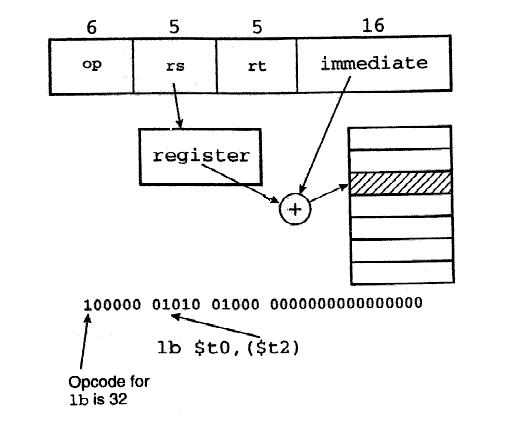
This kind of addressing is also known as indirect register addressing since the operand is at the memory location whose address is in the register.
MIPS PC-relative addressing
PC-relative addressing is used for conditional branches. The address is the sum of the program counter and a constant in the instruction.Here is an example to help you understand it.
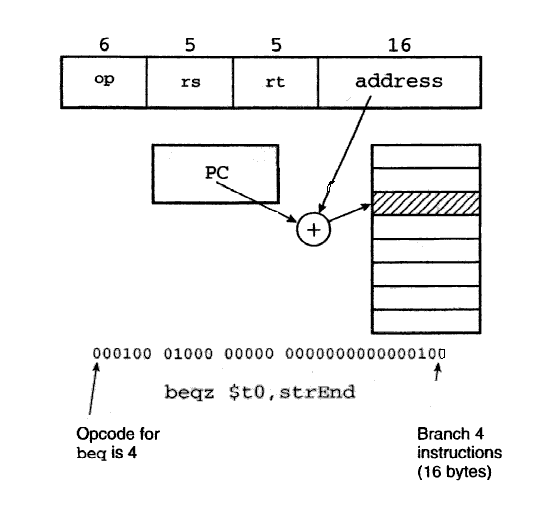
An Example Using Base addressing
Program min-max.s is an interesting program using the base-addressing mode.It searches an array of words for the biggest and smallest integer elements.
The .word directive is used to set up an array of 15 four-byte words in the data section.
An array data structure is a named list of items stored in memory.
The following picture illustrates an array of words stored in memory.

Here is the program min-max.s for you to study. The lw instruction is used to load each word into a register.
##
## Program Name: min-max.s
##
## - will print out the minimum value min
## - and the maximum value max of an array.
##
## - Assume the array has at least two elements (a[0] and a[1]).
## - It initializes both min and max to a[0] and then
## - goes through the loop count - 1 times.
## - This program will use pointers.
##
##
## $t0 - point to array elements in turn
## $t1 - contains count of elements
## $t2 - contains min
## $t3 - contains max
## $t4 - each word from array in turn
##
#################################################
# #
# text segment #
# #
#################################################
.text
.globl __start
__start: # execution starts here
lw $t1,count # $t1 is the counter and contains array size now.
la $t0,array # $t0 contains base address of the array.
# $t0 will point to the array elements.
lw $t2,($t0) # $t2 is current min, like initializing min = a[0].
lw $t3,($t0) # $t3 is current max, like initializing max = a[0].
add $t0,$t0,4 # $t0 is updated and points to a[1].
add $t1,$t1,-1 # $t1, the counter is updated.
loop: lw $t4,($t0) # load next word from array
bge $t4,$t2,notMin # skip if a[i] >= min
move $t2,$t4 # otherwise, copy a[i] to min
notMin: ble $t4,$t3,notMax # skip if a[i] <= max
move $t3,$t4 # otherwise, copy a[i] to max
notMax: add $t1,$t1,-1 # decrement counter
add $t0,$t0,4 # increment pointer by 4 to the next word
bnez $t1, loop # continue if $t1 > 0, exit loop when $t1 == 0
la $a0,ans1 # print prompt on terminal
li $v0,4 # system call to print
syscall # out "min = "
move $a0,$t2 # print result min
li $v0,1
syscall
la $a0,ans2 # print out "max = "
li $v0,4
syscall
move $a0,$t3 # print result max
li $v0,1
syscall
la $a0,endl # syscal to print out
li $v0,4 # a new line
syscall
li $v0,10 # Exit
syscall # Bye!
#################################################
# #
# data segment #
# #
#################################################
.data
array: .word 3, 4, 2, 6, 12, 7, 18, 26, 2, 14, 19, 7, 8, 12, 13
count: .word 15
ans1: .asciiz "min = "
ans2: .asciiz "\nmax = "
endl: .asciiz "\n"
##
## end of file min-max.s



